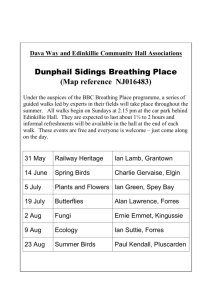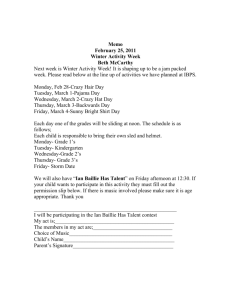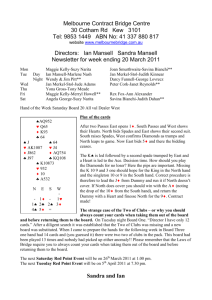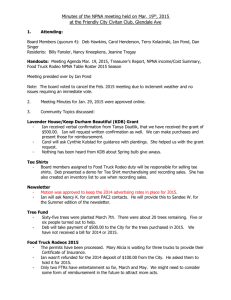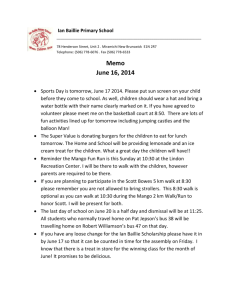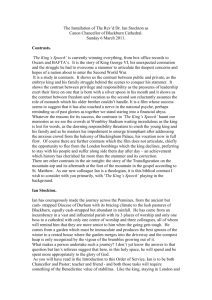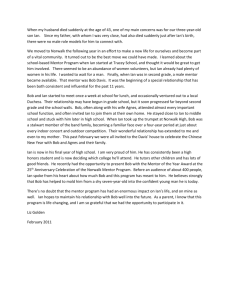Comm 1958
advertisement
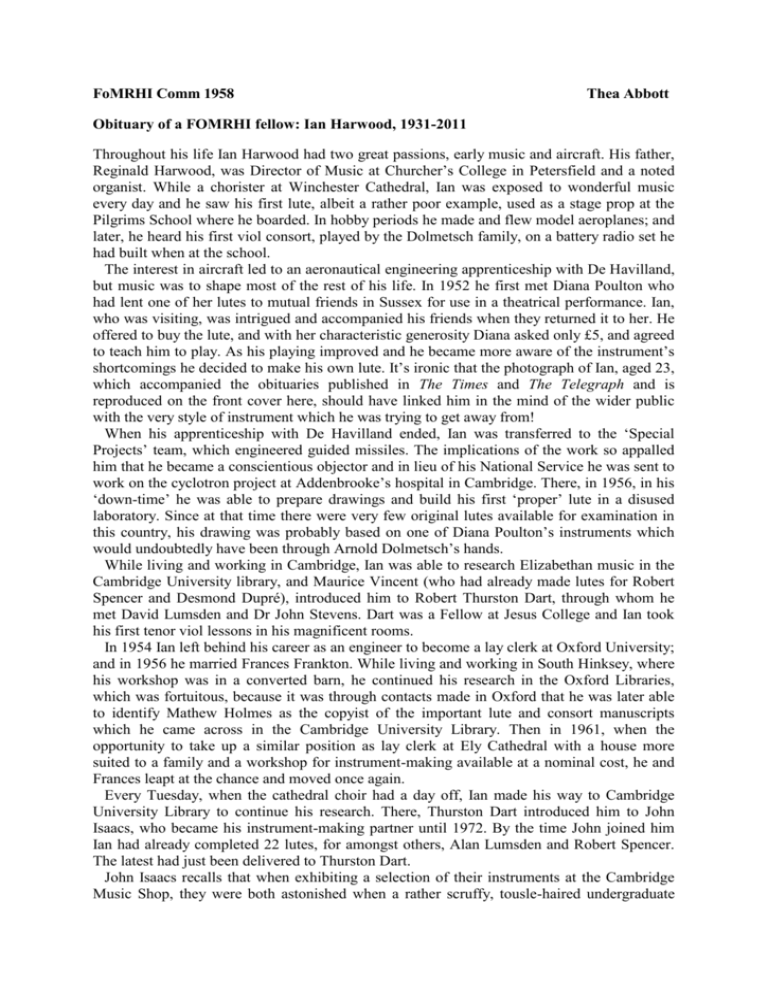
FoMRHI Comm 1958 Thea Abbott Obituary of a FOMRHI fellow: Ian Harwood, 1931-2011 Throughout his life Ian Harwood had two great passions, early music and aircraft. His father, Reginald Harwood, was Director of Music at Churcher’s College in Petersfield and a noted organist. While a chorister at Winchester Cathedral, Ian was exposed to wonderful music every day and he saw his first lute, albeit a rather poor example, used as a stage prop at the Pilgrims School where he boarded. In hobby periods he made and flew model aeroplanes; and later, he heard his first viol consort, played by the Dolmetsch family, on a battery radio set he had built when at the school. The interest in aircraft led to an aeronautical engineering apprenticeship with De Havilland, but music was to shape most of the rest of his life. In 1952 he first met Diana Poulton who had lent one of her lutes to mutual friends in Sussex for use in a theatrical performance. Ian, who was visiting, was intrigued and accompanied his friends when they returned it to her. He offered to buy the lute, and with her characteristic generosity Diana asked only £5, and agreed to teach him to play. As his playing improved and he became more aware of the instrument’s shortcomings he decided to make his own lute. It’s ironic that the photograph of Ian, aged 23, which accompanied the obituaries published in The Times and The Telegraph and is reproduced on the front cover here, should have linked him in the mind of the wider public with the very style of instrument which he was trying to get away from! When his apprenticeship with De Havilland ended, Ian was transferred to the ‘Special Projects’ team, which engineered guided missiles. The implications of the work so appalled him that he became a conscientious objector and in lieu of his National Service he was sent to work on the cyclotron project at Addenbrooke’s hospital in Cambridge. There, in 1956, in his ‘down-time’ he was able to prepare drawings and build his first ‘proper’ lute in a disused laboratory. Since at that time there were very few original lutes available for examination in this country, his drawing was probably based on one of Diana Poulton’s instruments which would undoubtedly have been through Arnold Dolmetsch’s hands. While living and working in Cambridge, Ian was able to research Elizabethan music in the Cambridge University library, and Maurice Vincent (who had already made lutes for Robert Spencer and Desmond Dupré), introduced him to Robert Thurston Dart, through whom he met David Lumsden and Dr John Stevens. Dart was a Fellow at Jesus College and Ian took his first tenor viol lessons in his magnificent rooms. In 1954 Ian left behind his career as an engineer to become a lay clerk at Oxford University; and in 1956 he married Frances Frankton. While living and working in South Hinksey, where his workshop was in a converted barn, he continued his research in the Oxford Libraries, which was fortuitous, because it was through contacts made in Oxford that he was later able to identify Mathew Holmes as the copyist of the important lute and consort manuscripts which he came across in the Cambridge University Library. Then in 1961, when the opportunity to take up a similar position as lay clerk at Ely Cathedral with a house more suited to a family and a workshop for instrument-making available at a nominal cost, he and Frances leapt at the chance and moved once again. Every Tuesday, when the cathedral choir had a day off, Ian made his way to Cambridge University Library to continue his research. There, Thurston Dart introduced him to John Isaacs, who became his instrument-making partner until 1972. By the time John joined him Ian had already completed 22 lutes, for amongst others, Alan Lumsden and Robert Spencer. The latest had just been delivered to Thurston Dart. John Isaacs recalls that when exhibiting a selection of their instruments at the Cambridge Music Shop, they were both astonished when a rather scruffy, tousle-haired undergraduate walked in, picked up a renaissance recorder which Ian had made, and played an accurate double-octave chromatic scale. It was, of course, David Munro. John recalls that Ian said he had no idea the recorder was capable of such a thing. Julian Bream was a regular visitor to the workshop, and among today’s makers both Michael Lowe and David Van Edwards visited the Ely workshop before they made their first lutes. A few years later, Stephen Gottlieb and Martin Bowers, who had already begun to build instruments visited the Ely workshop in search of advice and information from Ian. Though Ian’s early instruments were undoubtedly an improvement on the heavy Germanbuilt, guitar-like instruments most commonly available, they were still a long way short of the instruments which were built once Stephen Murphy and Stephen Gottlieb had made their fine drawings in the museums of Europe. Nevertheless, Anthony Rooley deemed Ian’s lutes a revelation, saying ‘Ian created wonderful light lutes . . . and they floated, almost, as one picked them up to play’. For many years the Early Music Shop sold a kit for making a 7course lute, which was based on an instrument provided by Harwood and Isaacs. It was while living in Ely that Ian and Frances’s two children, Jenny and Peter, were born. Jenny remembers the main benefit of an instrument-making father was that her pet hamster always had the very best quality sawdust for his cage. One of Ian’s great discoveries, came about as a result of some brilliant detective work. He was able to attribute a series of manuscripts in the Cambridge Library (including Dd.2.11) to the hand of a single copyist, Mathew Holmes, who had been a ‘singing man’ and ‘precentor’ at Christ Church College, Oxford at the end of the 16th century. Richard Newton, who was editor of the Journal at that time wrote, ‘Your latest discovery made me splutter my marmalade all over the table at breakfast . . . This is the greatest discovery since Juval first plucked the lyre!’ In 1964 Ian was awarded the Tovey Prize for research into Elizabethan music for this work. The Society’s recent publication of a facsimile edition of Dd.2.11 was a further tribute to Ian’s scholarship; and a few months before his death friends were able to travel to York, where he spent the last months of his life, to present him with a copy. On a summer walk across the Sussex Downs Ian and Diana discussed the possibility of starting a society devoted to the lute. They came up with a list of 40 people who might be interested. They were far from certain of the response they would get, but Ian’s letter must have sounded, to use a musical expression, just the right note, because 32 people replied in favour of the idea. On October 20th 1965 the Inaugural Meeting was attended by 20 people (a further 8 sent apologies) and the aims of the new Society were discussed. They were simple and to the point: To encourage the revival of the lute To build a library of music To hold meetings at which music would be played To publish a journal. Harry Potts (who is still a member today) suggested widening the remit of the Society to cover the study of the instrument itself; a move which must have pleased Ian particularly, since his own research, combined with Diana’s emphasis on authentic technique, had by now convinced many players that they needed authentic instruments. Arnold Dolmetsch’s son, Carl, gave a seal of approval to the proceedings at that first meeting when he said, ‘My father would have been overjoyed to see this gathering.’ In Septemer 1957 Ian, Diana Poulton, David Lumsden and Harry Potts attended a conference at Neuilly-sur-Seine, near Paris, on the lute and its music. They were the only English participants and their presence aroused curiosity. Ian recalled sitting through ‘a great many very serious discussions’. When the group was asked which of the English lute tutors should be re-published David Lumsden replied, ‘I should do Robinson because he’s got the best jokes.’ Ian recalled that didn’t go down at all well! Ian made his professional debut as a counter-tenor and lutenist in 1960, and formed the Campian Consort in 1967. He was often called on to play in other ensembles. Anthony Rooley recalls that, in the early 1960s, he and Ian shared the ‘pit’ at Glyndebourne under Raymond Leppard’s direction during performances of La Callisto and Poppea. In 1972–73, while curator at Fenton House in North London, Ian met the gamba-player, Elizabeth Page, who was rehearsing for a performance there, and subsequently took viol lessons with her. He began to build early viols and was one of the first to realise that, unlike baroque instruments, which had been the accepted norm, the early viol was built without a sound-post; in 1974 ‘Early Music’ published his paper, An introduction to renaissance viols. In the early 1970s at Morley College, in south-east London, the principal, Barry Till, who had already brought in Anthony Rooley and James Tyler to teach the music, recognised that, with so many developing players a course in instrument making would make an important addition to the College’s range of classes. He invited Bob Hadaway to lead a stringinstrument building course; and in 1972 Ian took over one of the classes. Among his students in those days were Martin Edmunds and John Pringle. Later he taught at the London College of Furniture, where among his many students were Paul Thompson, Stephen Barber, Sandi Harris, Gary Bridgewood and Tom Neitzert. By this time it was clear that Fenton House was unable to provide suitable workshop space for Ian’s viol-making, and he moved, with Elizabeth Page, to live and work first in Harrow and later in Henfield in Sussex, where between 1973 until 1978 he made viols almost exclusively. During this period Ian, John and Martin travelled together round Europe examining instruments and meeting other players and makers at the Festivals and meetings which were part of the Oude Muziek programme. John Pringle subsequently moved to live and work in the United States. Ian and Martin Edmunds continued to build viols though their practice took them in different directions. Ian based his models on an anonymous instrument from the Dolmetsch Collection, while Martin worked from the Linarol and Ciciliano instruments in Brussels and Vienna. They remained close collaborators, and Martin says that it was Ian’s academic standing that gained them entry to museum collections to research and measure period instruments. Ian’s rather wry sense of humour is shown in Martin Edmund’s account of a lengthy lecture on the double pitch standard which Ian gave. He picked up the fact that the audience was becoming restive and self-deprecatingly said, ‘He who touches pitch shall be defiled.’ Causing a general lightening of the atmosphere. In 1979 Ian married Christine Bland. As the demand for his viols slowed Ian entered a period of what he, and Carl Dolmetsch before him, called ‘a time of financial stringency’, and returned to aircraft engineering. First restoring old wooden aeroplanes, which as he said himself, didn’t require as high a level of woodworking skill as lutes and viols had done; and later, from 1992, importing and modifying a micro-light which was a modern French version of the Flying Flea. Two of these planes were adapted for use by paraplegic pilots, a fact of which Ian was very proud. In 1997 Christine died and Ian returned to music. The last 14 years of his life were devoted to musical research and, when Robert Spencer died, Ian was appointed President of the Lute Society. He was awarded the MBE for services to Music Heritage on 19 March 2008 He will be remembered, amongst many other things, for his overview of the music of the 16th century and especially his contribution to the ‘Consort of Six’. His book, Six Seueral Instrvments, brings together the results of his lifetime research and will be published in the near future. Throughout his life Ian’s insight and skill made him loved and admired, his research and teaching was always generous and academic, and never commercial or competitive.


